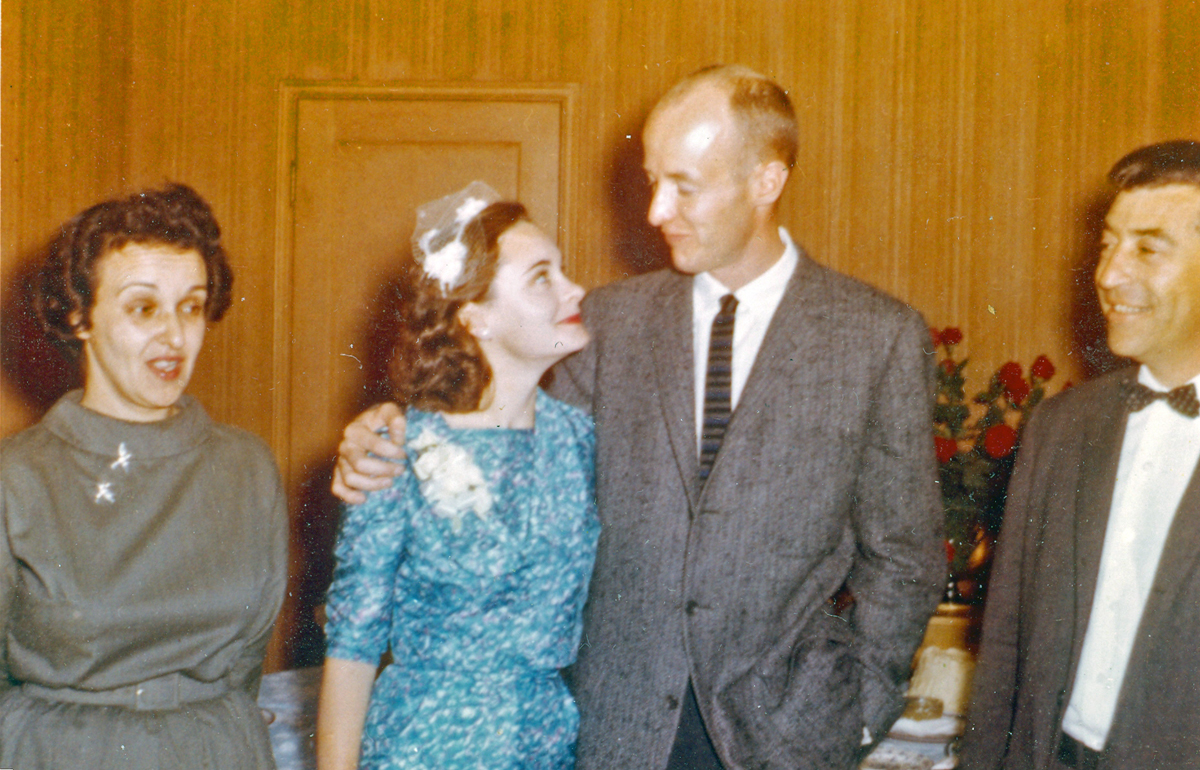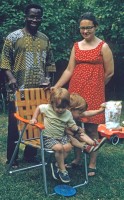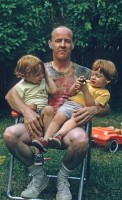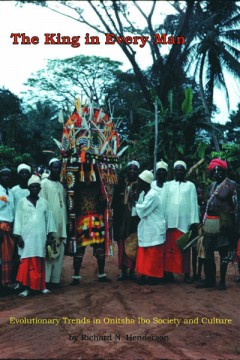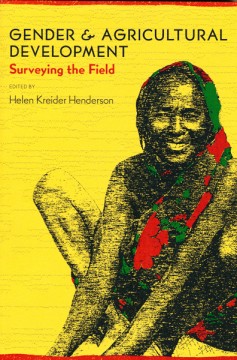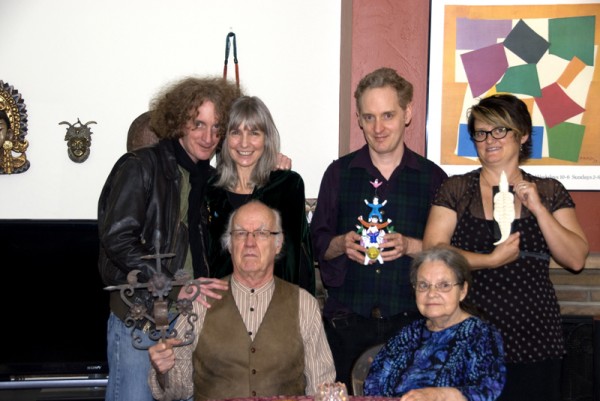Helen and I met at Berkeley as graduate students in August 1958. We soon became close friends, then lovers, and were married in August 1959. 1
We went to Nigeria together in 1960 under Dick’s Ford Foundation Research Grant. Our fieldwork in Onitsha was not well-prepared as a research project ahead of our arrival there, indeed the choice to go to Igboland was a rather abrupt, “last-Minute” one; I had devoted my plans to study among the Yoruba, which would not have been a good choice for me. 2
In those days the Department of Anthropology at Berkeley adopted what might be called a “sink-or-swim” policy for field research conducted by us social/cultural anthropologists, and in our case both of us had managed to become social-science “dog-paddlers” at best by the summer of 1960.
We did learn to swim in that sense in Onitsha. The experience was “wonderful” —O di egwu, as Onitsha people would say, literally “It is wonderful”, an expression of utter amazement (though not necessarily entailing the positive qualities implied in the English translation) . The milieu of that part of what was then labeled Eastern Nigeria, was indeed full of wonders, and I hope that the readers of this website get some sense of that as they explore my reports of it.
In the fall of 1962, we returned to Berkeley, where I completed my dissertation in August 1963 while Helen served as cook, bottle-washer, and social/psychological protector of a resident madman, while working herself on her own PhD..
My madness had two definite phases. The first was serious psychological depression, where I stared at pages aimlessly, moping while one of my brightest student colleagues, writing on his own dissertation, kept calling me complaining: “I’ve only written twelve pages today!” he would say, while I sat stupefied by my stasis (and increasingly envious of his prowess). Helen finally told him to go away. Then I visited a University of California psychotherapist, to whom I tried to present my psychoanalytic impressions (assuming that that was expected) while he sat before me responding in total silence. After two sessions, I abandoned him in righteous anger, and went from there to systematically writing my dissertation in rather short order. (I have always wondered how that “therapy” worked, which it did.) 3
By that time I had been offered a job at Yale,. I had presented a brief paper at the American Anthropological Association meetings on the subject of the Onitsha Ofo stick as a ritual object, which was apparently enough to convince the great Yale linguist Floyd Lounsbury that I was worthy of an appointment.
We drove our 1950 Ford sedan east across the country to take up my job at Yale. It contained in its backseat our sole accompanying piece of furniture, a large plywood home-made hi-fi speaker cabinet, thanks be prayed to my father and his willingly-administered carpenter’s skills building this precious device (along with other high-fidelity gear — a tweeter,tuner, amplifier, phonograph player). We were determined to be accompanied by good music (Berkeley’s marvelous KPFA radio station had sustained us mightily at this time when we were otherwise operating in distress).
Our vehicle’s Wyoming license plates created some astonishment there at the time –, most easterners had apparently never seen a bucking bronco image on the backside of a car. (We didn’t think of ourselves as pioneers, but we did convey what may have seemed a somewhat rustic style.)
These are perhaps extraneous details, but I provide them to give a sense that our travels were (unwittingly at first) covering considerable distances in social styles ( and social class).
The Years in New Haven, Connecticut
Below, you see a large, multi-storey former mansion, located at 360 Edwards Street, at the very northern limit of Yale campus. This massive building had previously been converted into apartment housing, mainly for visiting faculty and graduate students. This location gave us our shelter for the first five years after our arrival in New Haven.
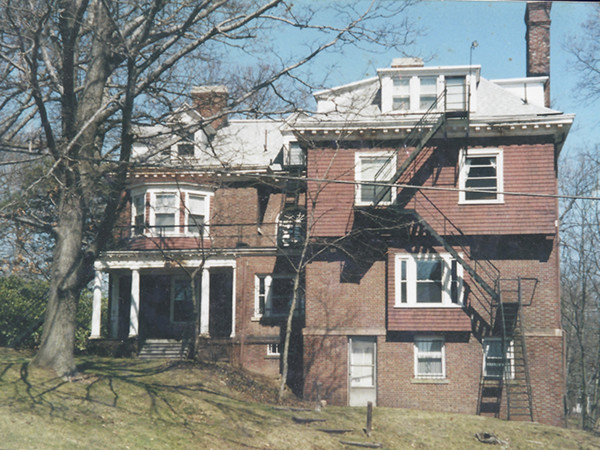
The building here faces away from the street, toward the south, its backside looking over a rather large campus parking lot. Our quarters were at the right side of the top white facade. (During our residence, the building had no fire escape this photo was taken years after our departure from New Haven in 1972).
Retrospectively, the absence of a fire escape was unwise; the entire building was heated by a large and very old oil-burning furnace. I also had an interesting experience one night, finding I had to crawl along the parapet you see marking the roof-edge (when an inside door had become inadvertently locked.)
We had a small kitchen, living room (behind the “bay” windows), a bedroom, and a bath. When our twin boys were born in 1969, we engaged another room for their beds, with an electrical sound-monitoring device so we could hear any voicing activity. (this was a very short-term solution; we moved a year after their birth into ample housing on the other side of town.)
Below, our living room enlivened with visitors. Here you see the bay windows from the inside. Early in our residence there, when some social problems arose in the building, Helen contacted the building’s manager, , who then solicited her to act as the building’s “supervisor”. Helen enjoyed this duty, finding ample opportunities to expand social contacts while employing her rich sense of humor. (She had unusual talent as a cartoonist and chronicler, which converted the building’s residents into a kind of social club. Everyone got to know each other to some degree.),
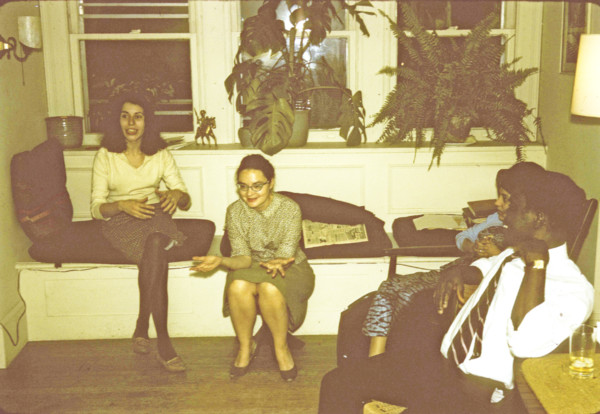
By this means, we were also e able to bring in friends who needed housing – some new members of the Yale Anthropology Department faculty, and some Igbo-speaking student-friends at various times. My parents even stayed briefly in one of the apartments while they visited the east coast (for the first and only time). Here at left, , Helen holds forth to guests and house-mates..
Sue Chipman, who you see above left beside Helen, and her husband Abram Chipman, were psychoanalysts living on the second floor, who became lifelong friends (and Chip, an expert musicologist, greatly enhanced my knowledge of classical music. He wrote record reviews for High Fidelity Magazine at the time, and occasionally regaled me with differing assessments of various recordings of Mahler symphonies.)
This residential arrangement was definitely not typical housing for Yale faculty: I well remember one particular fellow professor, who owned a mansion elsewhere in New Haven, who briefly visited me here, and stared in shock (perhaps in horror) at the very low ceilings of our apartment — I knew from having visited him that he was familiar with very high ceilings ( as well as rooms displaying expensive original paintings — we made do with cheap prints on our walls).
I taught Anthropology at Yale University in New Haven, Connecticut from 1963 to 1972, while Helen worked on her dissertation, giving birth to twin boys Kevin and Michael in February of 1969, then finishing her dissertation in June of that year. She then taught Anthropology as an Assistant Professor at Wellesley College near Boston, commuting there from New Haven while I tended our lads at home (with the help of a hired Nanny), mentored (and was mentored by) various colleagues and students, and worked up the research materials that eventually culminated in my ethnohistorical book The King in Every Man: Evolutionary Trends in Onitsha Ibo Society and Culture (Yale University Press, 1972; Lightning Source Edition, 1996, front cover shown below at right.).
Our New Haven years were both immensely exciting and extremely difficult (See Chapter 8, “Nigeria Collapse….” in this website for a few more details.). The Nigeria-Biafra Civil war 1967-70 became a time of considerable anguish and depression for all of us academics who sought justice for the Igbo-speaking people of Nigeria during that ruinous time in global history.
We became devoted to trying to advocate for Biafra, and to send monetary support to the suffering people. In Biafra, with however little in the way of effective results. (Our Biafra Children’s Relief Fund did send 98% of the funds we collected to the major relief agencies involved (Roman Catholic and Angican Missions), but our efforts to generate political concern fell on very deaf ears. (Many national-level political issues also involved us at this time, participating in marches protestinng the Vietnam War, for example.)
While in retrospect it is clear to me that my physical health considerably declined in those years –I was a devoted smoker at the outset, until a bout of double pneumonia (and stern warnings from a medically informed friend) let me to cease that habit entirely. But I also became chronically hyper-tense, given the continual presence of so many competing arenas of social interaction.
I write (re-write, 2022) this page having just learned of the death of Robert Farris Thompson , a perennial star of the Yale academic firmament. A flood of memories intrude,, and I also read a very detailed obituary essay reflecting on his life. (mainly his achievements at Yale). I met Bob early in my ventures at Yale, and we became good friends and mutually informative colleagues. But I could not miss the fact that he was in a number of ways a far superior being in the realms of academic performance: he was polyglot, and always ready to perform his multiplicities. He became what I saw as the Sid Caesar of African Art History: capable of evoking a wide range of situations, then embroidering each of them with finely coordinated verbal ,visual, musical, and bodily art. He would convert a lectern into a drum set. Performances like that were far beyond my ken — I could only regard him with awe.
I did obtain something at Yale that lessened my sense of distance from spontaneous creativity and enabled me to recognize and accept my own limitations and to proceed along a career that became more realistic, open-minded, and actively creative.
The intervening agent was the advent of psychedelic chemicals at Yale, which (providentially, one might almost imagine) coincided with my arrival there. I had longed for psychedelic experience ever since reading the works of Aldous Huxley (VERY early in my intellectual career, 1952 and thereabouts, and had sought them without success while a student at the University of New Mexico), but the opportunities only appeared (primarily through the agency of students) at Yale. My experiences with marijuana, LSD, psilocybin, and peyote were all profoundly self-transforming. At the time, the opening of possibilities was so positive and many-sided that I could see no disadvantages to these means of self-discovery. (Later, at Arizona, I came to recognize the negative effects of over-indulgence — I should have evolved “micro-dosing’ by that time; after over-doing my involvement, I did eventually “drop out” of these activities.)
If I began my experiences at Yale with a tense, “up-tight” (secretly a bit frightened) demeanor, I ended it with eyes wide-open (and much more expressive in communicating with other people — completely without awareness at first, I found that I drew in people with what were newly expressive eyes). In retrospect, I am very thankful that I was able to have these experiences, and with them my long-term health began to improve — hypertensity radically declined as I become more content to be occupying my own skin.
The Years in Tucson, Arizona
When I received a Professorship at the University of Arizona in 1972, we moved across the country to Tucson and Helen had to begin reconstructing her career in that location, directing both her research and teaching interests strongly into problems of gender and international development. First working with the Office of Arid Lands Studies at the UA, she did research in Niger, then (with the Consortium for International Development) in Burkina Faso (then Upper Volta), and (with various food, agricultural, and urban planning research groups) in Egypt, Mauritania, Botswana, Chad, Kenya,Tanzania, Senegal, Morocco, and Mali. She became Project Director for the Women in Development Program in the Bureau of Applied Anthropological Research at the UA (with its Consortium associates), working with many colleagues and research assistants. She published a welcome volume on problems of gender and agricultural development4 and until her retirement in 2001, she taught very popular courses on Gender and Development at the University of Arizona and advised many students both inside and outside of the Bureau. She was very highly (and warmly) regarded by her colleagues, staff, and students at the University of Arizona.
My career at the University of Arizona moved in rather different directions. I tried experimenting in various kinds of teaching methods, became strongly involved with n conflict mediation processes, and made an extended effort to write a book on the Onitsha Kingship Interregnum I had experienced, in light of subsequent events in Nigeria. This did not come to fruition during those years, as I struggled to integrate the large trove of visual and audio information I had collected with textual writing. At the time, I could not figure out how to meld these processes. (The website I write here today has become my ultimate form of these efforts.)
Ventures in Symbolic Antrhopology
Below, the cover page of the UCLA-sponsored African Arts (Vollume 21, no. 8, 1988). The cover picture is my photograph of the Awkuzuzu Ijele msquerade in active performance (taken in 1961).
My perennial interest in the symbolism embodied in African Arts became central concern of my life from the time I first landed in Onitsha. Formal academic focus progressed during my Yale career evolved through discussions with Robert Farris Thompson comparing icons of Yoruba and Onitsha Igbo cultures.
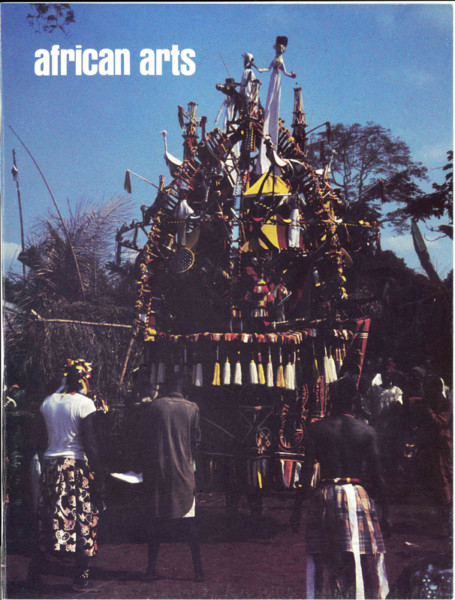
After departing from Yale, . I presented an initial version of my interpretations of the Onitsha Ijele art form at a public lecture at the Univerisity of Arizona in 1977, and a subsequent version at the Igbo Arts Symposium of the African Studies Association annual meeting held at UCLS in October 1984. This in turn was followed by presentations at the Seattle Art Museum and the University of Washington African studies seminar in 1986. In all of these presentations I benefited greatly from discussions with colleagues.
I considered this publication (with the late Ifekandu Umunna) one of the most significant contributions of my entire career and I present the whole of it in a section elsewhere in the website: go to Chapter eight, “Chronicles of Styles” where you will see a full page presenting the entire article, “Leasership Symbolism in Onitsha Igbo Arts and Ijele”.
I was disappointed when a colleague charged with assessing faculty performance for the year 1988 dismissed it — its origin as a production of “the arts” (as opposed, I gathered, to “the sciences”) made it of marginal significance in his eyes. I rest my case with the original performance — see it presented elsewhere in these pages. (I do understand that the current School of Anthropology at the University of Arizona has developed greater appreciation of and respect for the cultural importance of aesthetic symbolism than was evident during my tenure at the Department there.)
Devotions to Deep Ecology in Arizona
In the late 1970s and early 1980s, I began to pursue projects aiming to develop ecologically more sensitive food-producing practices at the local level, , first in Tucson where a number of investors formed the Goat and Garden Group. This small initial group expanded — beginning in 1988 — into a massive project focused on the vicinity of Cascabel, Arizona.
This project was fundamentally the brain-child of Jim Corbett, a man of unusually far-sighted vision and devotion to realizing his ideas. As a founding member of the Goat and Garden Group, he then led us into this new creation — an effort to preserve and expand the ecological viability of the San Pedro River Valley (and its environs). As a participant in the GGG, I was drawn into this venture, little grasping at the outset where it would lead. 5
So I participated in the founding of the Saguaro-Juniper Corporation, which has later expanded into a multiple set of mutually-articulating organizations, all devoted to the cause of extending enlightened food-production while preserving wildlife corridors along the San Pedro River drainage in southern Arizona.
Remarkably, one crucial catalyst of these developments was a young man I had first met at Yale, a student majoring in Mathematics named Tom Orum. who had spent time in Ethiopia woriking on a Yale-sponsored teaching project. We had bonded during a brief term at Yale, and after Helen and I went to Arizona he came to visit us, decided to put down roots here, married a fellow explorer in the emerging saguaro-Juniper world named Nancy Ferguson, and together they became quite central figurtes in the evolution of this new, expanding and very complex social-cultural-ecological. experiment. Their work has become definitive in ordering an efficient coopreation among a widley-diverse group of participants.
Folowing their leadership, I became actively involved in many of the groups’ activities, and while doing so eventually built two websites — https://saguaro-juniper.com, and https://sanpedrovivervalley.org — and contributed to the establishing of other organizational developmets that emerged in this now-massive conservational project (see https:// sweetwatercenter.org; https://cascabelconservation.org. )
Helen also contributed substantially to this process, largely by means of financial support at crucial points in our organizational evolution. My participation in what I would label “the Saguaro-Juniper Projects” was intensive — I would say the major pursuit of my life — from 1988 until 2008 (when Helen’s illnesses came into sharp focus and I responded appropriately to that situation.).
Brief Return to onitsha (1992)
During the late 1980s and early 90s, Helen sought to activate a return to our research focus, working with our late Onitsha colleague Ifekandu Umunna’s wife, Nneka, who had returned there recently herself and was talking about a long-postponed funerary ritual involving a maternal relative who had died during the Civil War. Helen developed the idea of videotaping this ritual (which would involve a considerable number of Nneka’s relatives). I decided I would accompany her and act as an assistant in the process. We did undertake this adventure, though with quite unexpected results. I have published an account of this operation in this website: see Chapter eight, “Some Aftermaths”, the page on “1992: Brief Encounters…..”
Conclusive academic burn-out
During these same years, I struggled through a very modestly productive academic performance in the UA Department of Anthropology and retired from teaching in 1996 (in retrospect, “completely burned out” was by that time an appropriate self-designation.),
By the turn of the year 2000 I realized that Helen was developing early stages of a type of dementia that her mother (and mother’s sister) had previously suffered. 6 For Helen, both powers of recall and recognition (and then, of physical mobility) waned sharply as her Alzheimer’s disease progressed, and she could no longer speak for herself academically or otherwise (which is why this text was begun and written solely by me instead of by both of us). After living for three years in the excellent Pacifica Adult Care Home in Tucson, she died April 12 2017. We held a friends Memorial for her May 14 and the University sponsored a Symposium in her honor at the School of Anthropology on September 8, 2017.
Below, a picture of the Henderson-Kreider Clan taken on November 24, 2011 (the eve of Dick’s 80th birthday). The pose I struck for this image was mock Grant Wood “American Gothic” 7, with (back row, from left to right) our son Kevin, his wife Anne Helwig, our son Michael, and his wife Margaret McClelland. As I write this we who survive live in Tucson, including my sons and their wives.
Addendum (2022): Some Sources of my Deep Affection for Persons of Jewish Descent (and my commitment to life-long processes of learning/teaching)…..
During the time when I grew up in Casper Wyoming from the 1930s into the1950s. my contact with actual Jewish people was minimal, there was hardly any real contact at all. Anti-Semitism was not an evident feature of my family, and had very little impact on my social life.
My mother provided me with the 1943 issue of the Encyclopedia Brittanica, so we then got an array of supplementary yearly publications from that source, and therefore when news of the Holocaust began to filter out publicly around 1945 I immediately learned of it in considerable shocking detail. I focused somewhat upon it, and so stored up the knowledge (and sense of that experiential horror ) in my consciousness. That’s about the sum of first knowledge. Thereafter, I never regarded the Jewish condition “objectively”, but always with some sense of sharing suffering, an abiding sense of compassion for those subjected to undeserved suffering.
Having become an enthusiastic jock-athlete during my years in grade and high school in Casper, and in my first year in colleges at the University of Wyoming, my early focus was largely on sports heroes, though my mother had tried to open my eyes to other persons of merit, adventurers, for example, female writers, other directions of accomplishment. At one point, for example, she suggested I read Willa Cather, , but I was oblivious — Ernest Hemingway was my first literary hero (when I moved beyond accounts of famous football players), and I never touched that marvelous lady-writer’s work (nor most other intellectual sources of that kind) until many years later.
My mother had of course been spot-ion in her opinions of such matters. It was only when ,after acting upon my newly-discovered (and jock-strap-failures-induced) prime motivation of escaping my current life-courses in Casper Wyoming ,, I joined the Air Force in 1951, and —in a barracks at Biloxi Mississippi in early 1952 where I was learning radar-focus electronics — I met men of my age who seriously read books.8
Seeing that I was bright-eyed, they began “feeding me” these unfamiliaar objedts, the first revelation being Signmund Freud’s “The Interpretation of Dreams”, which immediately transformed my sense of life-directions, leading me to begin searching to grasp the vast ranges of human consciousness and being. (Jung was a necessary next step into richer dimensions of meaning, but Freud was pivotal, and of course he was conspicuoursly Jewish.) So my first Jewish icon was a person of very brilliant mind.
The other great book my Biiloxi -barracks (home-Boston-based) friends gave me was The Perennial Philosophy by Aldous Huxley. This led me into spiritual questing, meditation, pacifistic orientations, etc., and directed me into a new commitment: I would become an anthropologist (Huxley spoke warmly of this field, an that was enough for me; psychedelics, another of his emphases, would come later.). All this happened in 1951-52, which included drastic locational changes as well.
By October 1954, having followed my new directions, I arranged a 3-mohth’s-early discharge from my four-year commitment to the Air Fprce, and I was accepted for admission as an uundergarduate student in Anthropology at the University of New Mexico in Albuquerque. 9 It was overall a wondrously good choice despite its basis in some largely misleading information from my two informants, former fellow football-players in Casper who were now residing in Albuquerque when I stooped there enroute to my new 1952-3 military assignment in Point Arena, California 10
My initially closest contact at the University of New Mexico was with Professor Stanley Newman, a Jewish expert in linguistics who had studied under Franz Boas (the main “Founder” of American anthropology). Dr. Newman arranged to provide me with a series of private lectures to make up for the fact that my military discharge was in October of 1954 while classes at UNM had started early in September, so I appeared on the scene quite late in the term . He patiently (and on his own time) brought me up to speed in his course in introductory linguistics, a profound introduction into this wonderful domain of scientific methodology directed toward culture patterns that became a major guide for my career (though I did not pursue linguistics as a primary specialization, it decisively framed my thinking thereafter). This wonderfully gentle, quiet, thoughtful man became a model for me in more ways that I can fully understand.
Then there was Dr. Leslie Spier. I cannot do him justice here, though the memories range widely and fill me with admiration. (You can look him up on Wikipedia.) He was a small, frail figure at the time, visibly unwell, and this was his last semester before retirement. I think he came to UNM on a one-semester basis,. His course on native American cultures was what was being called “too a-theoretial” byt the avante-garde students, but it was packed with information about a wide range of cultures/socieiteis, in many of which he had spent time. He had traveled widely in the west when the main means of transport for locals was horseback, beginning in the nine-teens, and he had clearly participated in a wide range of ways of life., aspects of which he could relate in vivid detail, often rich in subtle humor. I registered his sense of deep devotion to observing, recording, and reporting the rich variety of socio-cultural experience.
It was an honor for me to help him drive back to California at the end of his herm there. I wish I had written about him at t that time. Unfortunately, I was too inarticulate to be able to talk to him about the meanings of the Judaism/Christianity divide etc.
He was a rich source of stories about all aspects of his own distinctive fieldwork among native groups in the southwest., and was quietly very rich in humor: once he told me of a comment once made during an introduction to someone given him by his son, who had been quite young at the time (he later became an anthropologist himself, I believe): “This is my Dad; he’s a ‘Doctor’, but not the kind that does you any good!” 11
My next relevant subject is Dr. Harry Basehart, who was not himself Jewish but a devoted social scientist coming out of what was then the new Harvard School of Social Relations led at the time by the eminent theoretician Talcott Parsons. Harry’s coming to UNM in the spring of 1955 radically changed the Department of Anthropology there from something of a theoretical backwater (emphasizing processes like “cultural diffusion”, “culture areas”, and the like) into the forefront of new anthropological theory (soon to be personified by iconic figures like Clifford Geertz, also coming from the Harvard School of Social Relations).
Having recently encountered (and embraced) the challenging “functionalist” theory and methods of the charismatic Bronislaw Malinowski (presented to me by Professor Florence Hawley Ellis of UNM, her influential figure in my intellectual development at that time), I was quickly converted into a “Parsonian”, a very challenging transformation due to the complexities of these theoretical schemes (somewhat beyond my intellectual capacities, at the time and even now, I fear).
Harry in effect took me under his wing and in the summer of 1957 gave me the fieldwork opportunity of research among the Apache people living on the Mescalero Reservation near Ruiodoso, New Mexico. There I encountered his colleague, David M. Schneider of the University of California (Berkeley). Somehow I deeply bonded with this (to me, typically gentle) Jewish man, and in the fall of 1958 I was admitted to U.C. Berkeley as a Teaching Assistant — therefore having financial support from the outset, a necessity for me at that time. (You can look up Dr. Schneider on Wikipedia.)
I will be unable to do full justice to the immense richness of my “Berkely Experience”. There I met life-long Jewish friends (Allen Hoben, Leonard Plotnicov), met d(and soon married) the love of my life (Helen Kreider),and encountered an impressive array of academic professionals, from Schneider to Reinhard Bendix, Lloyd Fallers, Clifford Geetz, Robert Murphy, Sherburn Washburn , and many others —these were new, great stars in the firmament of the social sciences. A number of more entrenched faculty members were also present, and considerable resistance was being raised against the new perspectives. being introduced. So I entered a scene which was bristling with intellectual energy-in-conflict, for which I was psychologically poorly-equipped to grasp/manage.
I fell afoul of these oppositions, not at all an inevitable outcome but one that captured me largely due to my own social incompetence. I failed to consult one professor regarding application for research among a n African group in which he was expert. My supportive professors urged me to consult him, but I procrastinated out of shyness, so that when I had developed a complete proposal for research and he saw it , with no prior contact from me, , he baked at the prospect of my pursuing research in the location in question. .
This produced a catastrophic response in me, hard to describe in this vast time-remoteness, but — in the intense social/intellectual atmosphere of this location, which was already severely challenging my capabilities — I had always operated in a condition of high competence in writing examinations and term papers, but had very limited abilities in spontaneous verbal expression. I could write a good subject text, but was drastically inept at social, verbal interaction of any spontaneity
I speculate that this weakness was largely a product of my childhood — within my family, I had received very limited training in becoming verbally articulate: “Pa’s not much of a talker”, my college-educated mother once observed of her high-school-dropout husband, and I too had not developed much skill in spontaneous verbal arts.) Therefore it was not a good thing when I was assigned an oral defense without having completed a prior a written thesis.
This culminated in a Ph.D. oral examination in (for some reasons the Department had dispensed with a Written) which I failed completely, catastrophically, and yet Dr. Schneider refused to allow this event to be registered as a Failure. How he managed this feat I may only speculate, but he mad it stick, and soon thereafter i was attending an interview for a Ford Foundation grant to do field research in Africa, was directed by a grantor to look into the prospect of working in the community of Onitshaa in Eastern Nigeria, was awarded the grant, and soon found myself enroute (with Helen, my new wife in her ne capacity as holder of her new Masters Degree in anthropology) overseas. (Schneider left UCB in 1960 when I was still in the field, going to the University of Chicago where he soon became Chair in Anthropology. Other UCB colleagues of his also departed around that time.)
The extent of psychological damage I endured through this entire episode was never measured externally, and I can merely guess at it. In retrospect, I know the depths of depression were profound, and I also recall that afterwards for a considerable time I often experienced difficulty finishing sentences during conversations where I knew what I wanted to say but words stayed lost. . Eventually I speculated that I had suffered some kind of “stroke”, but whatever the facts, , I recovered from the condition gradually both in the two years in West Africa and then the subsequent year of writing the dissertation in 1962-3.
My psychological and social recovery definitely progressed during fieldwork in Nigeria — interactions with Igbo-speaking people contributed to my developing new degrees of social toughness that have never entirely failed me ever since, and I would rate my current psychological health at age 90 as good, including verbal facility. ( My current thought is to say, “Go figure…..)
Afterwards, Dr. Schneider’s support (now indirect) never failed as I proceeded to engage in a modestly successful academic career, first as an Associate Professor at Yale (where I taught from 1963-72) and then as a full Proessor at the University of Arizona (from 19762 to my retirement in 1996). I would not assess my career as “sterling”, but would consider it as adequate, (see the full range of my current website here for your own source of information regarding that matter.) The main point here is that none of it would have happened without Schneider’s support. at the critically pivotal time. I feel resonabluy certain that suicicide was the most likely alternative future for me in those dark moments in 1959. The prospect of it definitely weighed on my immisserrated mind.
This immense debt of gratitude to Dr. Schneider by no means exhausts my memories of positive relationships established and maintained with people of Jewish descent. As a graduate student at Berkeley, i had valuable supportive contacts with fellow students Allan Homen and Leonard Plotnicov. During the years at Yale, psychologists Abram and Susan Chipman became close friends, while Abner and Anne-Marie Shimony of Boston University and Wellesley, Colleage, and Ruth Ginsberg (a Syracuse-era friend of Helen) were consistently valuable colleagues and friends for both me and Helen. At the University of Arizona, Norman Yoffee and Ellen Basso were treasured anthropological associates,, and Myra Dinnerstein gave invaluable suppor to Helen as she struggled to find a place in this (for her, entry-level) academic situation. Ellie and Si Reichlin appeared in different contexts, sources of delightful times spent together..
I could continue listing other important Jewish friendships, but let this overview suffice. The treasures my Jewish contacts have offered me include not only intellectual brilliance and social warmth, but a perhaps hard to describe feature — a commitment to sensing and actively committing the self to supporting others in whom one senses certain needs along with both situational disadvantages yet willingness to struggle to achieve those needs. A rather clumsy summary, of what i have learned to value, perhaps, but it will have to do for me here.
Then, having “completed” this essay, I r suddenly realized I had completely forgotten one of the most important examples of all. While living at Yale, one day in 1966 I called my PCP, Dr. Saul Milles, complaining of severe distress. Listening to me speak, Dr. Milles immediately dispatched a crew of medics to our tiny third-floor apartment in the old mansion described elsewhere in this essay, where his crew carried me bodily on a stretcher, down the narrow twisting stairways and then off to Yale-New-Haven Hospital, where under the doctor’s direction I was placed in an ice-and-alcohol bath that brought my body temperature down from 106 degrees. I had double pneumonia. A simple fact: Dr. Saul Milles saved my life at that time.
On another occasion, he diagnosed and directed the fixing of a physical problem I had that was potentially serious but which had baffled other doctors. He was (and remains) my Gold Standard for what a PCP could be for a patient.
One more important (and final!) example comes to mind. In the mid-1970s, Helen and I encountered a rocky time in our marriage due to my considerable philandering. We learned of a Yoga class being offered at Temple Emmanuel in Tucson by a tiny, 92-yea-old woman named Camilla Bersu, a Holocaust survivor. We and perhaps 20 other participants learned the basics of these complex crafts under her all-seeing direction. Her words had magical qualities — I can still recall the sounds of her urging us to let our spines relax as we stretched out on the floor, letting the cords grow “longer-n-longer-n-longer….”
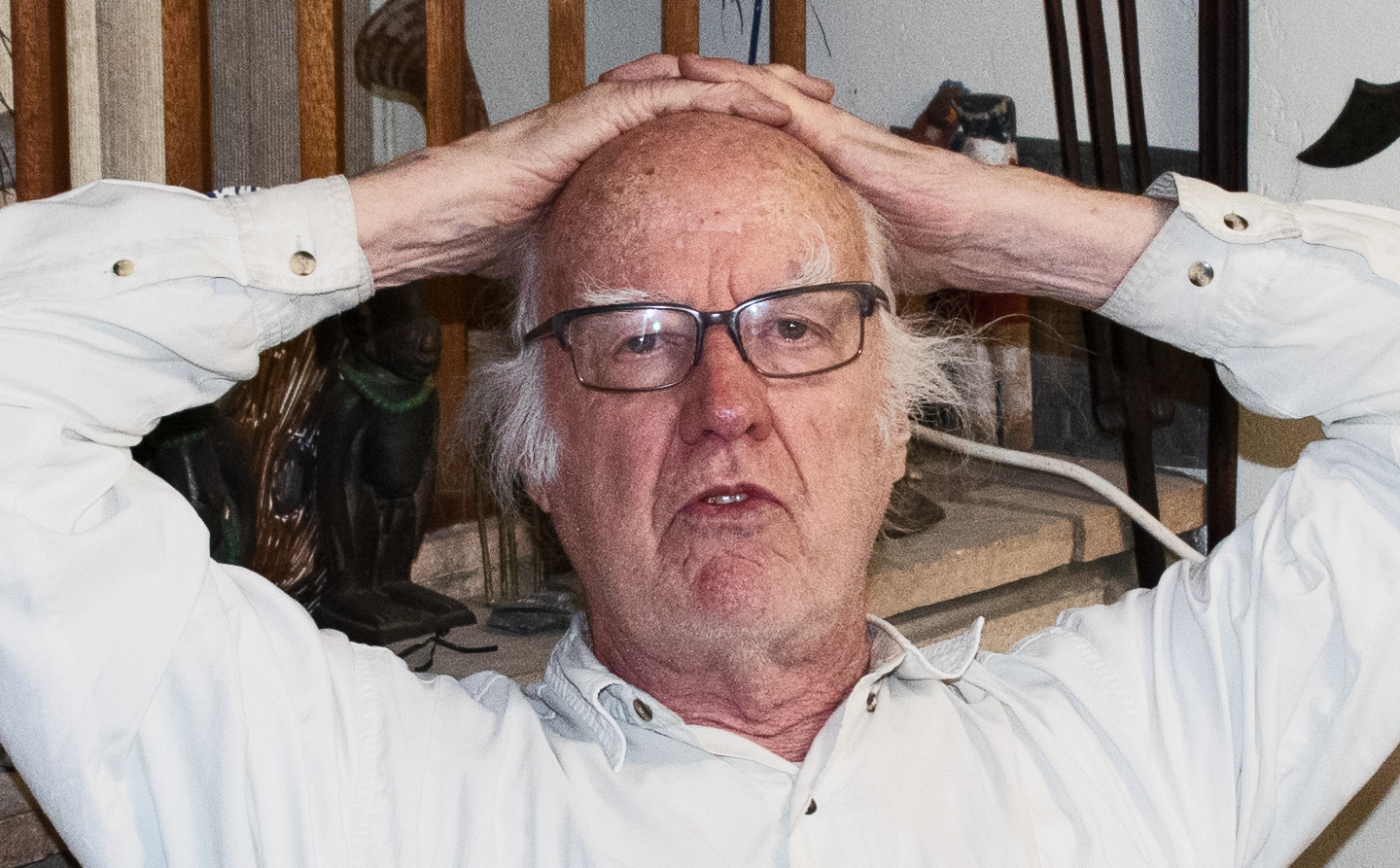
“Striking for the gentle, striking for the kind,
Striking for the guardians and protectors of the mind,
An’ the poet and the painter far behind his rightful time,
An’ we gazed upon the chimes of freedom flashing”
Excerpt from Bob Dylan, “The Chimes of Freedom Flashing”, In Another Side of Bob Dylan, 1964
- Thanks are overdue to the late Judge Homer and Nita Kreider of Harrisburg Pennsylvania, and to the late Hugh and Ted Henderson of Casper, Wyoming. My mother was called “Ted” by all her friends; she detested her given name (“Lurene”, and only revealed it to me under pressure. I’m sure she got her preferred name from respect for her very strong character. [↩]
- “Igbo People”, (Ndi-igbo) were social-psychologically much more compatible with my own deep temperament. [↩]
- I should have thanked him; as it was, he received no feedback regarding his efforts. [↩]
- 1996: Gender and agricultural Development: Surveying the Field (with Ellen Hansen): University of Arizona Press. [↩]
- I must add here a remarkable fact: Jim and I grew up as children, living in neighborhoods not far apart, in small-town Casper, Wyoming. We never met, but even in his early life Jim’s reputation as a remarkable person spread well beyond his neighborhood: I had heard his name spoken among my friends in grade school, and his reputation was significant enough that I remembered his name when we first met, some fifty years later. [↩]
- The Physical Anthropologist Sherburn Washburn made the observation at Berkeley in one of our 1958-9 classes that the power of recall in the human mind is much more expensive of cerebral cortex than is that of recognition. As of 2022 — the Now of this writing — I feel I fully understand the meaning of that comment. [↩]
- I’m holding a Chiapas Iron Cross, thanks to a gift from anthropologist Barbara Voorhies, in place of the pitchfork brandished by Wood’s stoic farmer. [↩]
- These were men from the Boston area who, apparently under draft-pressures due tro the War, had enlisted to escape likely foot-soldier dury. I had felt no such pressures myself; escape was my sold motive. [↩]
- The basis for my choosing UNM as my academic option could easily become a separate chapter here, indeed a brief comic novel dealing with the serendipity of mistaken directions, but I will skip that here. [↩]
- This location was, a new-found geographical paradise whose numerous spiritual virtues are however best set aside here. [↩]
- For those unaware of the practice: People with Ph.D degrees may be addressed or referered to as “Doctor”. [↩]
